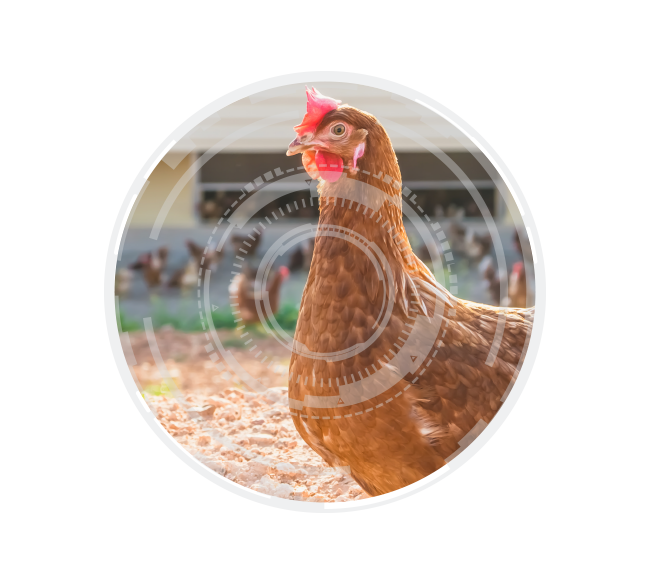Drastic genetic changes have occurred in many commercial broiler lines during the last years with regard to performance. This genetic improvement needs a corresponding adjustment of our knowledge about amino acid nutrition in broilers. Additionally, today broiler feed formulators are not only focused on minimising the costs. They also have to take into consideration environmental issues and the impact of feed on broiler health. Reducing excess dietary crude protein (CP) is an important way of addressing these issues. The least cost formulation of the diet according to the ideal protein concept is the best way to supply an economic and a balanced amino acids feed for broiler, which can help to reduce the nitrogen excretion during the rearing period.

What are the next limiting amino acids in broiler diets?
To reduce dietary crude protein levels in broiler feed, it is necessary to know which indispensable amino acids become limiting in diets and what the requirement of broilers is. The usage of feed use amino acids (methionine sources, L-Lysine sources, L-Threonine) in broiler feed is well established. Depending on the requirement assumed for each amino acid, Valine, Isoleucine, Tryptophan and Arginine are generally considered as the next limiting amino acids in broiler feed. Indeed, the amino acid composition of protein differs between feedstuffs and can impact the order in which amino acids become limiting in diets.The study carried out by Fernandez et al. (1994) on 8 – 21 day-old chicks determined which amino acids were limiting in corn soybean meal based diets. Amino acid levels of the control diet were according to an ideal protein specification. The authors used the deletion method (amino acid supply was reduced one after another) and observed average daily gain (ADG) and gain:feed ratio (G:F) of the birds. They confirmed that Methionine, Lysine and Threonine were the 1st limiting amino acids for broiler performance. It can be seen that Valine was the 4th limiting amino acid for broilers ahead of Arginine and Tryptophan for G:F (figure 1). Results for weight gain gave the same ranking of limiting amino acids.
Corzo et al. (2007) confirmed experimentally that Valine was the 4th limiting amino acid in cornsoybean meal diets for 21 – 42 days broilers. In contrast, Berres et al. (2010) formulated a cornsoybean meal diet without CP restriction by using L-Lysine, DL-Methionine and L-Threonine. The ratios of digestible amino acids to lysine were: 75% (Met + Cys), 65% (Thr), 18% (Trp), 70% (Val), 65% (Ile), 106% (Arg) at a CP-level of 18.7%. This diet led to poor body weigh gain which was improved significantly when L-Valine or L-Isoleucine was supplemented to Val:Lys and Ile:Lys ratio of 75% and 68%, respectively, during day 14 – 35. The limitation of Isoleucine before Arginine in corn-soybean meal diets when at least 2% of meat-and-bone meal is present in diet formulation for heavy broilers was demonstrated by Corzo et al. (2008).
In broiler diets with poultry by-product meal, Corzo et al. (2009) observed Valine to be limiting before Isoleucine until Isoleucine inadequacy starts to prevail, making further Valine supplementation futile
Valine and Isoleucine requirement in the literature
To better understand the amino acid requirements of broilers, knowledge of their carcass and feather amino acid contents is helpful. Stilborn et al. (1997) estimated the feather amino acid contents from broilers. The authors found a Val:Lys ratio of 198% at day 14. This ratio increased to 338 % day 28 and up to 378% at day 112. The corresponding Ile:Lys ratios were 145%, 234% and 283%. It shows the impact of both amino acids for synthesis of feather protein. In the carcass (without feather) an average Val:Lys and Ile:Lys ratios of 79% and 60%, respectively, can be measured (GfE, 1999). An exhaustive literature review show that there is a huge variability in published requirements with Val:Lys = 81% ± 19.7 and Ile:Lys = 70% ± 17.0 (figure 2)Figure 1: Order of limiting amino acids in the protein of a corn-soybean meal diet for chick
growth (FERNANDEZ et al., 2004). Columns with different letters are significantly
different (p < 0.05)
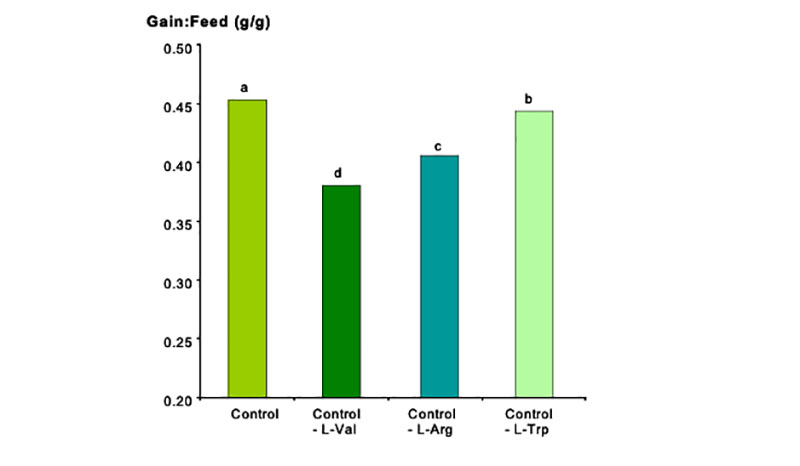
Figure 2: Compilation of available published requirements for valine and isoleucine expressed
as Val:Lys and Ile.Lys ratios. Each point represents one published requirement.

The Valine requirement of broilers as a ratio to Lysine
Due to the wide variation in published requirements, it is very difficult to interpret and reach conclusions about the Valine and Isoleucine requirements of broilers. In order to investigate this further, a database was built in which the available data on the Valine and Isoleucine responses and requirements of broiler were compiled. It could be found in world literature 28 valine and 66 isoleucine trials (articles or abstracts from scientific journals). To enter a trial in the database, the following minimum information was required:1. Ages of the tested chickens
2. Composition of the basal experimental diet. Nutritional values (apparent metabolisable energy and amino acid expressed in true digestible [TD]) were re-calculated with INRA-tables (Sauvant et al., 2004) so that the analysis could be based on complete amino acid profiles drawn from common source and to remove the variability arising from published values (expected ≠ analysed).
3. Measures of growth performance: average daily gain, average daily feed intake, gain to feed ratio. Carcass weight and yield, breast meat weight and yield were also entered when they were available.
The expression of the requirement as Val:Lys and Iso:Lys needs to test if TD Lysine level is sublimiting. This was done by graphical comparison to the TD Lysine requirement at different ages of modern broiler genotypes (adapted from Ross 308 (2007) and Cobb 700 (2008) management guides). In a second step, the TD amino acid profiles of basal diets were compared to Baker and Han (1994) in order to determine if any amino acids other than Valine or Isoleucine were limiting in the diet. In addition, because a 2-level study does not allow the determination of a requirement, such studies were eliminated from the compilation. At the end only ten published studies could be selected for the evaluation of Val:Lys ratio. The table 1 gives the experimental design of these studies.
Table 1: Experimental designs, recalculated nutritional values of the basal feed and broiler
performance of the best treatment in each of the 10 trials kept for the determination
of the TD Val:Lys requirement of broilers
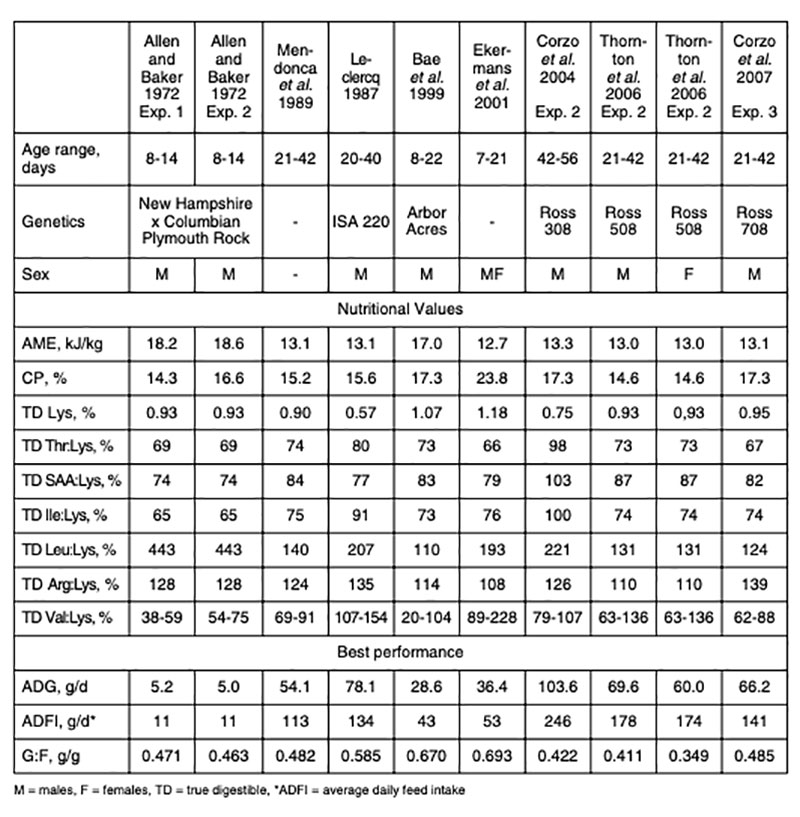
In order to estimate the TD Val:Lys ratio which optimises ADG and G:F ratio of broilers, the performance in the ten selected trials were represented in a curvilinear plateau model. The meta-analytical model took into account a trial effect by estimating a plateau for each trial separately. The results are presented graphically in figure 3.
There is a clear response in ADG and G:F ratio to increased TD Val:Lys ratios, which validates the selection procedure. The TD Val:Lys ratio of 80% appears as a minimum to optimise broiler growth and feed efficiency
Figure 3: Effect of TD Val:Lys ratio on ADG and G:F
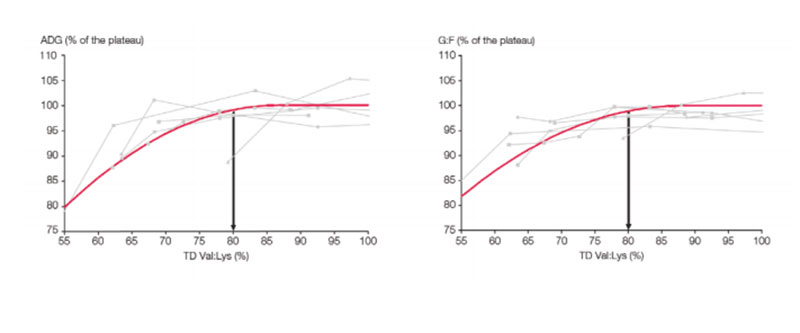
The compilation of the data for carcass parameter shows a strong effect of TD Val:Lys ratio on weight of carcass and breast meat (Corzo et al., 2004; 2007). However, carcass yield (Thornton et al., 2006, Corzo et al., 2004; 2007) and breast meat yield (Leclerq, 1998, Thornton et al., 2006, Corzo et al., 2004; 2007) were not affected. As carcass weight and breast meat weight increased together with increased Val:Lys ratios, the ratio between breast meat and carcass weight did not change. However, meeting the bird’s requirement for Valine is of key importance in ensuring the optimal usage of Lysine which is well known to increase breast meat yield (Berri et al., 2008).
The Isoleucine requirement of broilers as a ratio to Lysine
As explained above, trials must be selected based on TD Lysine, deficiency in one or more amino acids, lack of other information or number of levels for TD Ile:Lys ratio. As result, from 66 published trials only 6 trials fulfilled the conditions in order to evaluate the TD Ile:Lys ratio. The mean characteristics of the trials selected are presented in table 2. The 6 trials differ in the broilers’ ages, sex, genetics and nutritional values of the feed. This explains the differences in ADG, ADFI and G:F ratio between the trials.In order to estimate the TD Ile:Lys ratio that optimises ADG and G:F ratio in broilers, growth performance of the six trials were compiled using the same method as for Valine. The graphical results of this compilation are presented in figure 4. There is a clear response in ADG and G:F ratio to increased TD Ile:Lys ratios, which validates the selection procedure. A minimum TD Ile:Lys ratio of 67 appears to be necessary to optimises broiler performance.
However, it is important to notice that in four trials (Hale et al., 2004, Kidd et al., 2004, exp. 4, 5, 6) the authors used blood cells (animal product). Blood have a specific imbalance in their amino acid profiles, which is characterised by a relative high Valine and Leucine content and particularly poor level of Isoleucine. This raw material is often used in Isoleucine dose-response trials because it easily creates an Ile deficiency. It is well documented that the imbalance between these three amino acids (all
Table 2: Experimental designs, recalculated nutritional values of the basal feed and broiler
performance of the best treatment in each of the 6trials kept for the determination
of the TD Ile :Lys requirement of broilers
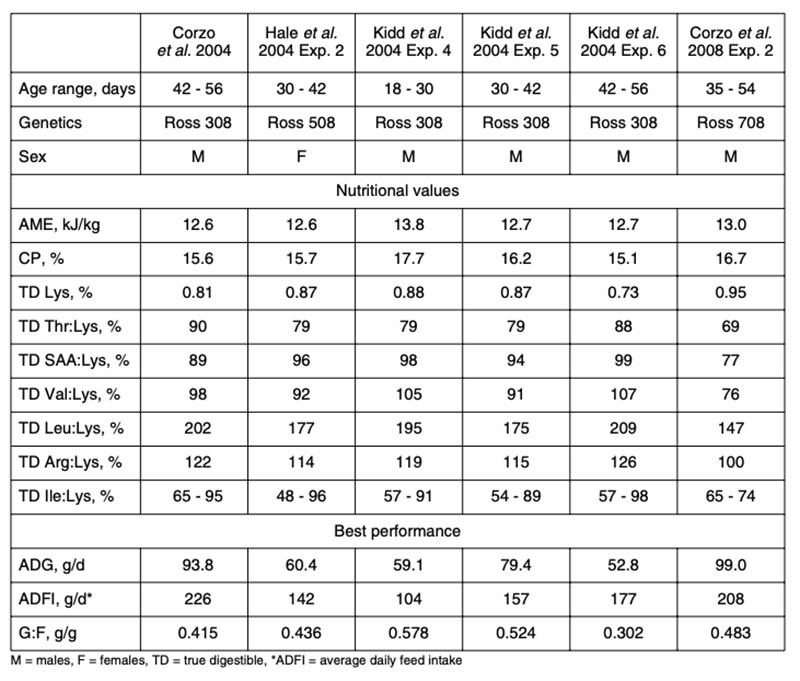
branched-chain amino acids) is a factor that impacts animal response in broilers (D’Mello and Lewis, 1970 a,b, Burnham et al., 1992) and piglets (Wiltafsky et al., 2010). D’Mello and Lewis (1970a) observed in growing broilers (7-21 days) that circulating levels of Isoleucine and Valine were lowered by an excess of Leucine. In addition, Valine and Isoleucine requirement increased with Leucine supply (D’Mello and Lewis, 1970b). Burham et al. (1992) observed that dietary Leucine set at 1.76 times the requirement level depressed chick growth. However, an excess of Valine does not seem to impact bird’s response to Isoleucine (D’Mello and Lewis, 1970a). Therefore, further trials in order to estimate the optimal Ile:Lys ratio in broiler diets without blood cells or high Leucine level are needed.
Figure 4: Effect of TD Ile:Lys ratio on ADG and G:F
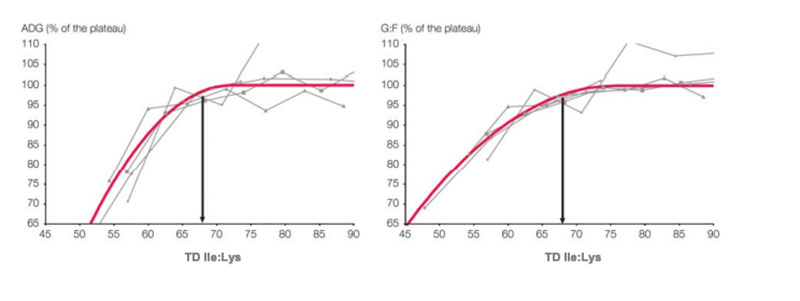
Practical implication for broiler diets
This review concerning the Valine and Isoleucine requirements of broilers allows to update the ideal amino acid profile (table 3) proposed by Ajinomoto Eurolysine S.A.S. in 2004.Table 3: Proposed ideal amino acid profile for broilers (true digestible AA relative to Lysine)

By using a minimum specification for each of these amino acids in formulations, it is possible to progressively determine the next limiting amino acid in broiler feed, and to establish the extent to which it is possible to reduce dietary crude protein through supplementation with amino acids. As an example, three grower broiler diets (14 – 28 days) were formulated to contain 13.4 MJ/kg AME and 1.05% TD Lysine, using the amino acid profile presented in table 3. The first simulations are based on wheat-soybean meal diet and the second ones on corn-wheat-soybean meal diet (figure 5).
It can be seen that the lowest CP level that could be achieved without any feed use amino acid was 29.2% with wheat and soybean meal. When DL-Methionine was added to the formulation, the lowest CP level that could be reached was 22.4% and the next limiting amino acid was Lysine. When LLysine was offered, the CP level dropped to 21.5% and Threonine became limiting. In both simulations, sulphur amino acids, Lysine and Threonine were the first limiting amino acids. L-Threonine supplementation allowed an additional reduction of approximately one percentage point of CP in both diet types. Then, in these vegetable diets, Valine was the next limiting amino acid before Arginine and Isoleucine, as already described at the beginning of this article. The supplementation of L-Valine allowed a further reduction of one percentage point of dietary CP.
In contrast, Isoleucine at 67% TD Ile:Lys ratio is the next limiting amino acid after Threonine in feed containing blood meal, followed by Arginine and Valine (figure 6).
Figure 5: Dietary CP level (%) in standard grower broiler diet (soybean meal was gradually
replaced by wheat or corn). Ranking of limiting amino acids (from left to right) and
lowest crude protein level achievable without supplementation with the
corresponding amino acid.
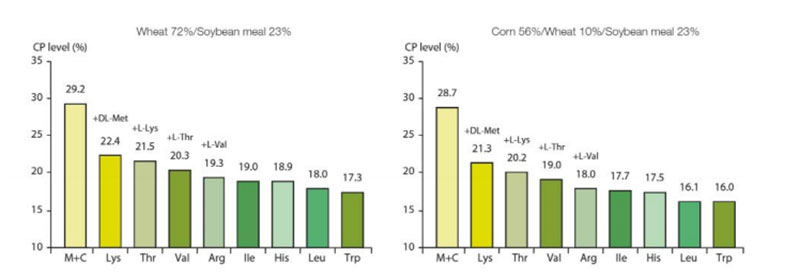
Figure 6: Dietary CP level (%) in standard grower broiler diet with blood meal and sunflower
meal (soybean meal was gradually replaced by corn). Ranking of limiting amino
acids (from left to right) and lowest crude protein level achievable without
supplementation with the corresponding amino acid.
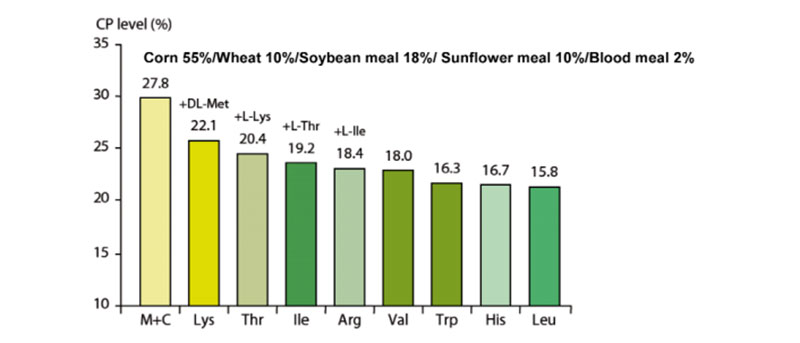
Conclusions
1. Valine is the 4th limiting amino acid in vegetable broiler diets based on wheat or corn2. Isoleucine becomes the 4th limiting amino acid, when blood cells or blood meal are used in formulations.
3. The TD Val:Lys and TD Ile:Lys requirements of broilers are 80% and 67%, respectively, to optimise performance.
4. Knowing the requirements of individual amino acids, feed formulators have more flexibility to reduce dietary crude protein levels.
5. L-Valine supplementation in combination with L-Threonine provides the opportunity to formulate technically, economically and environmentally better broiler feed.
References
AJINOMOTO EUROLYSINE S.A.S. (2004): Amino acid nutrition of the broiler chicken. Update on lysine, threonine and other amino acids. Ajinomoto Eurolysine Information No. 27.ALLEN, N.K. and D.H. Baker (1972): Quantitative efficacy of dietary isoleucine and valine for chick growth as influenced by variable quantities of excess dietary leucine. Poult. Sci. 51: 1292-1298.
BAE, S.H., J.H. KIM, I.S. SHIN and I.K. HAN (1999): Partition of amino acid requirement of broilers between maintenance and growth. V. Isoleucine and valine. Asian-Australas. J. Anim. Sci., 12: 388-394.
BAKER, D.H. and Y. HAN (1994): Ideal amino acid profile for chicks during the first three weeks posthatching. Poult. Sci. 73: 1441-1447.
BERRES, J., S.L. VIEIRA, M.T. KIDD, D. TASCHETTO, D.M. FREITAS, R. BARROS and E.T. NOGUEIRA (2010): Supplementing L-Valine and L-Isoleucine in low-protein diet corn and soybean meal all-vegetable diets for broilers. J. Appl. Poult. Res. 19: 373-379.
BERRI, C., J. BESNARD and C. RELANDEAU (2008): Increasing dietary lysine increases final ph and decreases drip loss of broiler breast meat. Poult. Sci. 87: 480-484.
BURNHAM, D., G.C. EMMANS and R.M. GOUS (1992): Isoleucine requirements of chicken: the effect of excess leucine and valine on the response to isoleucine. Br. Poult. Sci. 33: 71-87.
CORZO, A., E.T. MORAN Jr. and D. HOEHLER (2004): Valine needs of male broilers from 42 to 56 days of age. Poult. Sci. 83: 946-951.
CORZO, A., M.T. KIDD, W.A, DOZIER III and S.L. VIEIRA (2007): Marginality and needs of dietary valine for broilers fed certain all-vegetable diets. J. Appl. Poult. Res. 16: 546-554.
CORZO, A., W.A. DOZIER III, M.T. KIDD and D. HOEHLER (2008): Impact of dietary Isoleucine status on heavy-broiler production. Int. J. Poult. Sci. 7: 526-529.
CORZO, A.; R.E. LOAR II and M.T. KIDD (2009): Limitations of isoleucine and valine in broiler chick diets. Poult. Sci. 88: 1934-1938.
D’MELLO, J.P.F. and D. LEWIS (1970a): Amino acid interactions in chick nutrition. 2. Interrelationships between leucine, isoleucine and valine. Br. Poult. Sci. 11: 313-323.
D’MELLO, J.P.F. and D. LEWIS (1970b): Amino acid interactions in chick nutrition. 3. Interdependence in amino acid requirements. Br. Poult. Sci. 11: 367-385.
EKERMANS, L.G., K. STEENKAMP and I.C. SWARTS (2001): The response of chickens to increasing levels of valine. 13th Eur. Symp. Poult. Nutr. (Blankenberge, Belgium). Pages 294-295. Conference Proceeding.
FERNANDEZ, S.R., S. AOYAGI, Y. HAN, C.M. PARSONS and D.H. BAKER (1994): Limiting order of amino acids in corn and soybean meal for growth of the chick. Poult. Sci. 73: 1887-1896.
GfE (1999): Empfehlungen zur Energie- und Nährstoffversorgung der Legehennen und Masthühner (Broiler)/Ausschuss für Bedarfsnormen der Gesellschaft für Ernährungsphysiologie. DLG Verlag, Frankfurt am Main.
HALE, L.L., S.J. BARBER, A. CORZO and M.T. KIDD (2004): Isoleucine needs of thirty-to forty-two-old female chickens: growth and carcass responses. Poult. Sci. 83: 1986-1991.
LECLERQ, B. (1998): Specific effects of lysine on broiler production: comparison with threonine and valine. Poult. Sci. 77: 118-123.
Zusammenfassung
Valin und Isoleucin:– Die nächst-limitierenden Aminosäuren im BroilerfutterIm Rahmen einer Literaturstudie wurde geprüft, welche Aminosäuren nach dem Threonin im Broilerfutter limitierend sind. Dabei wurden die publizierten Studien zum Val:Lys – bzw. Ile:Lys Verhältnis einer Meta-Analyse unterzogen. Für die Auswertung wurden nur Dosis-Wirkungs-Studien verwendet, bei denen der Lysingehalt sub-limitierend war, keine weiteren Aminosäuren (außer Valin bzw. Isoleucin) im Mangel vorlagen und mehr als zwei Stufen getestet wurden.
Es konnte eine Val:Lys – bzw. Ile:Lys Relation von mindestens 80% bzw. 67 % (Basis: wahr verdaulich) abgeleitet werden, bei denen die tägliche Lebendmassezunahme und die Futterverwertung optimiert werden konnte. In Rationen, die auf Weizen, Mais und Sojaextraktionsschrot basieren, wird Valin nach dem Threonin limitierend. Enthalten die Rationen Blutzellen oder Blutmehl, begrenzt Isoleucin nach dem Threonin die Proteinsynthese.



